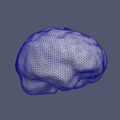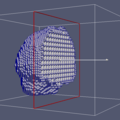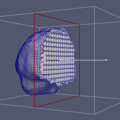Difference between revisions of "2014 Summer Project Week:Image To Mesh Conversion for Brain MRI"
| Line 1: | Line 1: | ||
__NOTOC__ | __NOTOC__ | ||
<gallery> | <gallery> | ||
| − | Image: | + | Image:BCC_Slicer.png | Brain BCC mesh |
| − | |||
Image:MeshBCCDeformed.jpg | Brain BCC mesh after MC | Image:MeshBCCDeformed.jpg | Brain BCC mesh after MC | ||
Image:MeshBCCSection.jpg | Brain BCC mesh (cross section) | Image:MeshBCCSection.jpg | Brain BCC mesh (cross section) | ||
Revision as of 02:58, 18 June 2014
Home < 2014 Summer Project Week:Image To Mesh Conversion for Brain MRIKey Investigators
- Fotis Drakopoulos (CRTC)
- Yixun Liu (CRTC)
- Andrey Fedorov (BWH/SPL)
- Ron Kikinis (BWH/SPL)
- Nikos Chrisochoides (CRTC)
Project Description
This project generates a tetrahedral mesh from an input labeled image. The method consists of two components:
- Body Centric Cubic (BCC) Mesh Generation
This component generates a Body Centric Cubic (BCC) mesh from a labeled image. Initially the generated mesh is homogeneous, that means does not distinguish different tissues. Later the component specifies which tissue each tetrahedron belongs to. Each tissue is capable of automatically adjusting its resolution based on its geometric complexity and the predefined subdivision criterion.
- Mesh Compression (MC)
This component deforms an input tetrahedral mesh towards the boundaries of the input labeled image. Two point sets are extracted for the mesh deformation. The first (source point set) consists of the exterior and interior surface vertices of the input mesh. The second (target point set) consists of the exterior and interior surface edge points in the input labeled image. Then the input mesh is deformed by registering the source to the target point set using a Physics-Based Non-Rigid Registration method.
Objective
- Develop a CLI Slicer module for the Body Centric Cubic (BCC) mesh component.
- Develop a CLI Slicer module for the Mesh Compression (MC) component.
Approach, Plan
- Currently the BCC and MC modules support the generation of single-tissue meshes. In the future the CLI modules will support multi-tissue meshes.
Progress
- The two implemented CLI modules are tested on various input labeled images.
References
- Tetrahedral mesh generation for medical imaging.
Fedorov A., Chrisochoides N., Kikinis R., Warfield S. College of William and Mary; Computational Radiology Lab and Surgical Planning Lab, Brigham and Women's Hospital, Harvard Medical School
- Mesh Deformation-based Multi-tissue Mesh Generation for Brain Images.
Yixun Liu, Panagiotis Foteinos, Andrey Chernikov and Nikos Chrisochoides. Engineering with Computers, Volume 28, pages 305-318, 2012.






